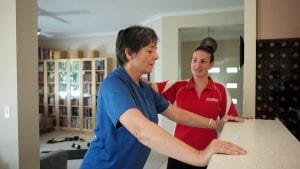The strict social distancing policies that have been implemented to limit the spread of COVID-19 mean that a lot of people are going to be spending a lot of time at home. Gyms are closed, public exercise equipment and playgrounds are closed, and it’s getting hard to find any workout gear online.
Why should we exercise?
The government has deemed exercise to be essential, and it is one of the few reasons you are allowed to leave you home! This is because Exercise has a huge number of benefits!
- Improves immune system
- Increases serotonin and “happy” endorphins
- Improves mood
- Improves sleep quality
- Reduces stress
How much exercise?
Current Australian exercise guidelines for the average adult includes:
- Doing any physical activity is better than doing none. If you currently do no physical activity, start by doing some, and gradually build up to the recommended amount.
- Be active on most, preferably all, days every week.
- Accumulate 2 ½ to 5 hours of moderate intensity physical activity or 1 ¼ to 2 ½ hours of vigorous intensity physical activity, or an equivalent combination of both moderate and vigorous activities, each week.
- Do muscle strengthening activities on at least 2 days each week.
How can we stay active in isolation?
The best thing you can do is build exercise into your day as part of your routine, to make sure you don’t forget about it. Keep yourself accountable by writing it down in your daily planner, or pop a reminder in your phone.
Here are 5 simple ways to get extra physical activity into your days at home:
1. Get up
If you are working from home you may find yourself sitting in front of your laptop or tablet for hours at a time. Make sure that you get up and move around at least once an hour, go get a drink, go to the bathroom, stretch, walk around the house for 5 minutes before sitting back down. When you’re on a business call – stand up and walk around. You’ll help yourself stay focussed and productive, and squeeze in a little bit of extra movement.
2. Take the stairs
If you live in an apartment building, or just have stairs inside your home, taking the stairs is a very effective way of increasing your cardiovascular fitness and muscular endurance. Take as many opportunities as you can to choose to take the stairs. If you have multiple items to bring up, make multiple trips. Do a few quick runs up and down on your computer breaks. You’ll be surprised how quick your heart rate goes up!!
3. No gym, no worries – use your body
There are a huge number of exercises you can do with just the weight of your own body, and these can be very effective for training at home as they don’t require much space or any equipment! Some of the biggest muscles groups will be targeted by performing some of these bodyweight moves:
- Squats
- Lunges
- Push ups
- Crunches
- Star jumps
- Plank
Just make sure you’re working at the right level for your current level of fitness and experience, good technique is the key to avoiding injury, so if you’re not sure, ask a professional.
4. Lounge room dance party
With many musicians now having extra time on their hands, you can find a wealth of great music, concerts and all kinds of streaming options online. Dancing to your favourite songs is not only a great way to exercises, it is a huge stress reliever. Get your kids to join in and take turns pick their favourite songs, make it a family affair.
5. Get outside
Even though we’re limited to where we can go, make sure you take the time to go outside at least once a day. The sunshine on your skin is important for your body’s vitamin D production, and the fresh air and open space does wonders for your mood and mental health. Whether it’s just to take the dog for a walk, a powerwalk around the neighbourhood, a bike ride, skate board or taking the kids outside to run our their wriggles – everyone benefits from getting outside every day.

